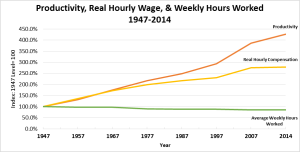Productivity and Real Hourly Compensation
For much of the 20th century, workers increased their productivity and were compensated accordingly, but today’s workers aren’t so lucky. Despite being more productive than ever, employers aren’t sharing the profits with workers, jeopardizing America’s middle class and increasing inequality.
From the end of World War II through 1970 American workers became more productive every year, and the increased productivity was matched by increased incomes. This reduced poverty, created a strong middle class, and made the standard of living among America’s middle class the envy of the world.
In the 1970s, things began to change. The productivity of American workers continued to increase, but employers didn’t share the benefits with workers and instead let their wages stagnate. Over the past four decades, and particularly since 2000, middle-class incomes have either barely kept up with inflation or lost ground. Instead, nearly all of the benefits of increased productivity have gone to those at the top of the income scale.
To measure productivity, we look at the dollar value of the average employee’s work in an hour, adjusted for inflation and price changes. Because state-by-state productivity figures are not available, we use national figures in this blog post.
As the graph above shows, productivity and compensation growth began to diverge after 1973. While productivity continued to grow rapidly, increases in hourly compensation were much less robust. Since 1973, productivity has grown at an annual rate of 3.0 percent, in comparison to worker compensation which grew at just 2.3 percent, according to figures from the Bureau of Labor Statistics. Over the course of a career, this difference can result in thousands of dollars in lost wages.
The graph above also illustrates that in addition to workers being under paid relative to their productivity, they are receiving fewer hours of work from their employers. On average, the total number of hours worked on a weekly basis was about 15 percent greater in 1947 than it was in 2014, according to figures from the Bureau of Labor Statistics. This, along with stagnant compensation, hurts the ability of hard working families to afford necessities, save money, and build a better life.
This trend is also clear when we look at labor’s share of business sector output in recent years. Essentially, when labor share is constant or rising, workers are benefiting from economic growth. When labor share falls, the compensation– productivity gap is widening.
Last year, the labor share reached one of its lowest points since 1947. In just a 15 year period, from years 2000-2014 the labor share fell sharply from 96 percent to 86 percent of the 1947 level, according to the Bureau of Labor Statistics..
As a result, the American middle class is in decline. Current trends have increased inequality even as the middle-class and lower-income families work harder, while upper-income households enjoy a continually rising living standard.

